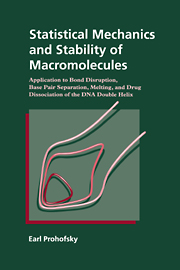 Statistical Mechanics and Stability of Macromolecules
Statistical Mechanics and Stability of Macromolecules Book contents
- Frontmatter
- Contents
- Preface
- 1 Introduction
- 2 Macromolecular stability
- 3 Lattice dynamics
- 4 Effective phonon theory
- 5 Premelting disrupted chemical bonds
- 6 Cooperative melting
- 7 Strained chemical bonds: salt and pressure effects
- 8 Bond disruption and conformation change: B to Z conformation change in DNA
- 9 Hydration effects: structural water
- 10 Helix with daunomycin intercalated: increased helix stability and daunomycin-DNA binding constant
- 11 Nonrepeating DNA
- 12 Cutting and splicing: junctions, inserts, and the replicating fork
- 13 Interaction between a helix and a single attached molecule
- 14 Energy considerations in bond opening
- Appendix 1 Helical lattice dynamics
- Appendix 2 Density matrix and effective phonon theory
- Appendix 3 Green functions
- References
- Index
11 - Nonrepeating DNA
Published online by Cambridge University Press: 16 September 2009
- Frontmatter
- Contents
- Preface
- 1 Introduction
- 2 Macromolecular stability
- 3 Lattice dynamics
- 4 Effective phonon theory
- 5 Premelting disrupted chemical bonds
- 6 Cooperative melting
- 7 Strained chemical bonds: salt and pressure effects
- 8 Bond disruption and conformation change: B to Z conformation change in DNA
- 9 Hydration effects: structural water
- 10 Helix with daunomycin intercalated: increased helix stability and daunomycin-DNA binding constant
- 11 Nonrepeating DNA
- 12 Cutting and splicing: junctions, inserts, and the replicating fork
- 13 Interaction between a helix and a single attached molecule
- 14 Energy considerations in bond opening
- Appendix 1 Helical lattice dynamics
- Appendix 2 Density matrix and effective phonon theory
- Appendix 3 Green functions
- References
- Index
Summary
Biologically significant DNA
Most biologically significant DNA helices are very long, so long that it is a useful approximation to assume infinite length. Helical lattice dynamics can then be used for analysis without having to resort to large dimensional calculations if the systems have a repeating base sequence symmetry. The studies in earlier chapters dealt only with DNA which had repeating symmetry. One can learn much about the dynamics of native DNA from a study of repeating DNA because the polymer DNAs share much of the dynamics, and often bracket the behavior of native DNAs. For example, the melting temperature of native DNA falls between that of poly(dG)– poly(dC) and poly (dA–dT)–poly(dA–dT). The study of repeating DNA is, however, a study of the material science of the material DNA. It deals with ‘perfect DNA’ and not with the complex broken symmetry material of biological significance.
The departures from symmetry are of great importance as biological information is contained in them. A biologically oriented study then requires methods that can deal with departures from repeating symmetry but can still be applied to very long DNA. In this chapter we develop methods useful with symmetry breaking structures. We get around the difficulties of dealing with large or infinite systems by starting with initial repeat polymer solutions and applying the new methods to achieve appropriate solutions. The approach was initially developed to deal with defects in crystals, the mathematical method is a Green function approach that is detailed in Appendix 3.
- Type
- Chapter
- Information
- Statistical Mechanics and Stability of MacromoleculesApplication to Bond Disruption, Base Pair Separation, Melting, and Drug Dissociation of the DNA Double Helix, pp. 146 - 158Publisher: Cambridge University PressPrint publication year: 1995


